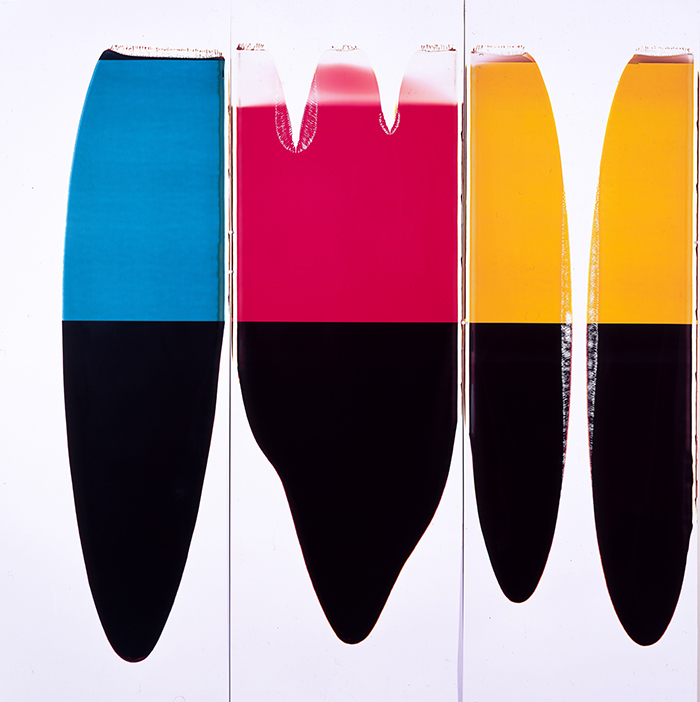The Polaroid Project
MIT Museum • Cambridge, MA • mitmuseum.mit.edu • Through June 21, 2020*
It’s one of the best origin stories ever: In December 1943, when his three-year old daughter asked her father why she couldn’t see—right away!—the photo he’d just taken of her, Edwin H. Land (1909–1991) thought, “Why not?” Land, who had already made his mark with the invention and manufacture of inexpensive light filters, went on a long walk to think through the concept of the instant photograph. He later claimed that within an hour, he had imagined the entire solution.

Ellen Carey, Pulls (CMY), 1997, Polaroid 20 x 24″ Polacolor composite, 83 x 66” (210.8 x 167.6 cm). © Ellen Carey, Jayne H. Baum Gallery, NYC, NY and M+B Gallery, LA, CA.
Land and his Polaroid Corporation, which he established in Cambridge, MA, in 1937, got to work. In less than five years, after plenty of scientific experimentation, the first Polaroid camera, called the Model 95, went on sale in 1948, on the day after Thanksgiving at the Jordan Marsh department store in Boston for the holiday season. The cameras sold out in minutes.
In the coming decade, Polaroid introduced a series of innovations and substantially improved the picture quality. The popularity of instant photography exploded. “The creation of the instant camera is one of the great chemical engineering triumphs of the 20th century,” says Deborah G. Douglas, one of the curators of The Polaroid Project: At the Intersection of Art and Technology, which, after traveling around the world, opened on October 11 at the MIT Museum, approximately one block from the site where instant film was invented.
The exhibition offers an extensive tour through the company’s fledgling days to its rise as the model high-technology company (Steve Jobs was said to have been an admirer) as well as Wall Street’s darling. With over 103 objects on display, including cameras, prototypes, tools, experimental films and other technical materials, the exhibition reveals Polaroid’s R&D process. This particular exhibition includes 41 important artifacts from the museum’s extensive Polaroid collection that were too large or fragile to travel to the other venues.
Guy Bourdin, Charles Jourdan, 1978, 1978, C-Print on Fujiflex paper, 35 x 46” (88.9 x 116.8 cm). © The Guy Bourdin Estate 2017. Courtesy of Louise Alexander Gallery.
Examples of rarely seen objects include Edwin Land’s personal large format camera, the 238 lb. behemoth that could take 20×24 inch pictures, and surprising test prints that document the invention of instant film.
Since Land constantly stressed that “industry is always better when art and technology are combined,” the exhibition also features over 256 original works by 120 artists who explored the artistic potential of Polaroid instant film, including Ansel Adams, Chuck Close, Barbara Crane, Harold Edgerton, Walker Evans, Hans Hansen, David Hockney, Dennis Hopper, Gyorgy Kepes, Robert Mapplethorpe, Robert Rauschenberg, Andy Warhol and William Wegman.
Land, who held 553 patents, second only to Thomas Edison, sought the company—and input—of artists. He hired art history students to work in his labs. He formed a long-lasting working friendship with Ansel Adams, who became a consultant in 1949. Polaroid’s Artist Support Program granted cameras, film and studio time to creatives such as Andy Warhol and Robert Rauschenberg, who tested Polaroid products and provided feedback. Many artists donated their explorations to Polaroid, which over the decades amassed more than 16,000 fine-art photographs.
The Polaroid spawned a broad range of subjects and styles. For example, Andrea Wolff’s sepia-toned insect studies, Meet the Beetles (2004), mimic 19th-century botanical drawings. Ansel Adams’s Cascades (1956), a soft, fluid image, makes way for the mysterious. In Pulls (CMY) (1997), Ellen Carey manipulates exposures to fashion works whose bursts of color call forth Abstract Expressionism. David Hockney’s Still Life Blue Guitar 4th April 1982, presents 63 photos in a rectangular grid as his playful homage to the Cubists.
A special section, called “Influences,” explores the outsized impact that Polaroid had on the Boston arts community. It spotlights four local artists, including a work by Cambridge-based Elsa Dorfman, the portrait photographer known for her use of a Polaroid 20×24-inch camera (one of only six in existence). Plus, an interactive video display screens Polaroid works by nine local contemporary photographers.
To unite the two galleries—the art with the technology—the once-ubiquitous Polaroid Spectrum logo runs through the center line of the two spaces, along the floor, display cases, benches and connecting wall.
Douglas hopes the exhibition appeals to the thousands of Polaroid retirees in the region, especially those in Cambridge, who, upon seeing the artifacts and art, will feel gratified about the impact of their work. It is “a celebration of ingenuity and creativity,” she says.
The humane ethos and trail-blazing spirit of Edwin Land resonate throughout the exhibition. He would have liked that art and technology share the same stage.
*Due to the sensitivity of the photographs, the exhibition will be shown in two parts, with a complete re-installation midway through. Part I will be shown through February 23, 2020; the exhibition will close February 24–March 8, 2020; followed by Part II March 9–June 21, 2020.

